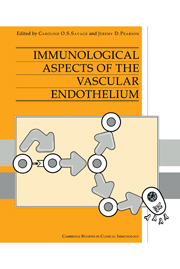Book contents
- Frontmatter
- Contents
- List of contributors
- Preface
- 1 New concepts of mechanisms in autoimmunity
- 2 Regulation of endothelial cell function by cytokines
- 3 Interactions between granulocytes and endothelium
- 4 The regulation of lymphocyte migration by vascular endothelium and its role in the immune response
- 5 Role of the vascular endothelium in immunologically mediated neurological diseases
- 6 The role of the endothelium in systemic lupus erythematosus and Sjögren's syndrome
- 7 The role of the endothelium in rheumatoid arthritis and scleroderma
- 8 The role of the endothelium in systemic vasculitis
- 9 Endothelial involvement in childhood Kawasaki disease
- 10 The role of the endothelium in thrombotic thrombocytopaenic purpura and haemolytic uraemic syndrome
- 11 The immunological role of the endothelium in organ transplantation
- Index
7 - The role of the endothelium in rheumatoid arthritis and scleroderma
Published online by Cambridge University Press: 04 August 2010
- Frontmatter
- Contents
- List of contributors
- Preface
- 1 New concepts of mechanisms in autoimmunity
- 2 Regulation of endothelial cell function by cytokines
- 3 Interactions between granulocytes and endothelium
- 4 The regulation of lymphocyte migration by vascular endothelium and its role in the immune response
- 5 Role of the vascular endothelium in immunologically mediated neurological diseases
- 6 The role of the endothelium in systemic lupus erythematosus and Sjögren's syndrome
- 7 The role of the endothelium in rheumatoid arthritis and scleroderma
- 8 The role of the endothelium in systemic vasculitis
- 9 Endothelial involvement in childhood Kawasaki disease
- 10 The role of the endothelium in thrombotic thrombocytopaenic purpura and haemolytic uraemic syndrome
- 11 The immunological role of the endothelium in organ transplantation
- Index
Summary
Scleroderma (systemic sclerosis)
Introduction
Scleroderma is a multisystem disorder with a high morbidity and mortality predominantly affecting females. The term ‘scleroderma’ was first coined by Gintrac in 1857, although the first written description of a case may have been as early as 1753. It is derived from the Greek for ‘hard skin’ which aptly describes the cutaneous manifestations dominating the patient's appearance. The other name for this disorder, ‘systemic sclerosis’, reflects the widespread organ involvement that determines the patient's survival. It is characterized pathologically by the overproduction of connective tissue, notably collagen, together with widespread vascular disease (see Fig. 7.1). Clinically, there is a spectrum of disease, ranging from widespread skin thickening (diffuse systemic sclerosis) and multiple internal organ involvement, to localized skin thickening limited to the face and extremities (limited systemic sclerosis). There is still a need for a good classification system. Once established in its full-blown form, systemic sclerosis is a disease process that is difficult to stem and often impossible to reverse. It still results in an unacceptably high mortality as well as significant morbidity.
The exact pathogenesis of scleroderma remains unknown, although various hypotheses to explain the underlying mechanisms have been proposed, including autoimmunity, innate fibroblast defects and primary angiopathy. There is a growing and compelling body of evidence to suggest that the earliest pathological changes lie in the endothelium and this will be reviewed here.
- Type
- Chapter
- Information
- Immunological Aspects of the Vascular Endothelium , pp. 153 - 172Publisher: Cambridge University PressPrint publication year: 1995
- 1
- Cited by



